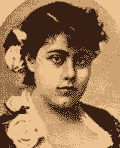Ayn al-Hayat Ahmad
| Ayn al-Hayat Ahmad | |||||
|---|---|---|---|---|---|
 | |||||
| Born | 5 October 1858 Cairo, Egypt | ||||
| Died | 12 August 1910 (aged 51) Paris, France | ||||
| Burial | Hosh al-Basha, Imam al-Shafi'i, Cairo | ||||
| Spouse | |||||
| Issue Among others |
| ||||
| |||||
| House | Alawiyya | ||||
| Father | Prince Ahmad Rifaat Pasha | ||||
| Mother | Dilbar Jihan Qadin | ||||
| Religion | Sunni Islam | ||||
Ayn al-Hayat Ahmad (Arabic: عين الحياة احمد; Turkish: Aynülhayat Ahmed; 5 October 1858 – 12 August 1910; meaning "Spring of life"[1]) was an Egyptian princess and a member of the Muhammad Ali dynasty. She was the first wife of Sultan Hussein Kamel of Egypt.
Early life
Princess Ayn-al-Hayat was born on 5 October 1858, and was the only daughter of Prince Ahmad Rifaat Pasha (1825 — 1858) and his consort Dilbar Jihan Qadin (died 1900).[2][3] She had two elder half-brothers, Prince Ibrahim Fahmi Pasha (1847 — 1893) and Prince Ahmad Kamal Pasha (1857 — 1907).[3] Prince Ahmad Kamal was a man greatly esteemed for his love of justice and the austerity of his life. Ayn al-Hayat, was still a child when her father met his tragic end.[2] Dark, petite, and vivacious, she had great charm. Her uncle, the Khedive Ismail, was very fond of her and took a personal interest in her education.[2]
Marriage
In order to introduce Ayn al- Hayat to study Isma'il used to say: "If you really try to learn your lessons and all your teachers are satisfied, I shall marry you to my son Hussein."[2] Ayn al-Hayat, as a child was so delighted with the idea that once when she was twelve she ran out to meet her uncle, who had come to see her, saying: "Today all my teachers are pleased. Now may I marry Hussein Agha bey?"[2] The marriage took place in 1873.[4] Prince Hussein was devoted to his wife, who at first appeared to be happy.[2] The two together had four children of whom only two survived,[5] a son, Prince Kamal el Dine Hussein, born on 20 December 1874, and a daughter, Princess Kazima Hanim, born on 16 July 1876.[6][7] While the youngest two children, a daughter, Princess Kamila Hanim, and a son, Prince Ahmed Kazim died young.[8] Then quite suddenly she insisted on a divorce and obtained her freedom. Princess Ayn-al-Hayat never remarried.[2]
Organization
She is remembered as a founder and first president of the Muhammad Ali Benevolent Society in 1909. The members of its community were all women, something till then unheard of in the annals of the Middle East.[2] Medical and financial advisers were the only men consulted. The society began by opening a dispensary for women and children in the populous quarter behind the Abdeen Palace.[2][9] The funds were chiefly supplied from the Princess's own resources and by donations from the Khedival family, as it then existed. According to the rules of the society, the president was always to be a princess of the ruling family.[2][9]
Death and aftermath
Princess Ayn al-Hayat died on 12 August 1910 at Paris, France and was buried in the mausoleum of Hosh al-Basha, Imam al-Shafi'i, Cairo. After her death, Princess Nazli Halim became the president of Muhammad Ali Benevolent Society.[10] She was followed by Princess Fawzia, who was the president of the organization to come from the royal house.[10]
Issue
Together with Hussein Kamil, Ayn al-Hayat had four children:[5]
- Prince Kamal el Dine Hussein[7] (Cairo, 20 December 1874 – Toulouse, France, 6 August 1932 and buried in a mausoleum in the Muqattam Hills), married and had issue;[6]
- Princess Kazima Hanim[7] (16 July 1876 – Rome, 29 January 1921 and buried in ar-Rifai Mosque, Cairo), unmarried and without issue;[6]
- Princess Kamila Hanim (died young);[5][8]
- Prince Ahmed Kazim (died young);[5][8]
Ancestry
| Ancestors of Ayn al-Hayat Ahmad | |||||||||||||||||||||||||||||||||||||||||||||||||||||||||||||||||||||||||||||||||||||||||||||||||||||||||||||||||||||||||||||||||||||||||||||||||||||||||||||||||||||||||||||||||||||||||||||||||||||||||||||||||||||||||||||||||||||||||||||||||||||||||||||||||||||||||||||||||||||||||||||||||||||||||||||||||||||||||||||||||||||||||||||||||||||||||||||||||||||||||||||||||||||||||||||||||||||||||||||||||||||||||||||||||||||||||||||||||||||||||||||||||||||||||||||||||||
|---|---|---|---|---|---|---|---|---|---|---|---|---|---|---|---|---|---|---|---|---|---|---|---|---|---|---|---|---|---|---|---|---|---|---|---|---|---|---|---|---|---|---|---|---|---|---|---|---|---|---|---|---|---|---|---|---|---|---|---|---|---|---|---|---|---|---|---|---|---|---|---|---|---|---|---|---|---|---|---|---|---|---|---|---|---|---|---|---|---|---|---|---|---|---|---|---|---|---|---|---|---|---|---|---|---|---|---|---|---|---|---|---|---|---|---|---|---|---|---|---|---|---|---|---|---|---|---|---|---|---|---|---|---|---|---|---|---|---|---|---|---|---|---|---|---|---|---|---|---|---|---|---|---|---|---|---|---|---|---|---|---|---|---|---|---|---|---|---|---|---|---|---|---|---|---|---|---|---|---|---|---|---|---|---|---|---|---|---|---|---|---|---|---|---|---|---|---|---|---|---|---|---|---|---|---|---|---|---|---|---|---|---|---|---|---|---|---|---|---|---|---|---|---|---|---|---|---|---|---|---|---|---|---|---|---|---|---|---|---|---|---|---|---|---|---|---|---|---|---|---|---|---|---|---|---|---|---|---|---|---|---|---|---|---|---|---|---|---|---|---|---|---|---|---|---|---|---|---|---|---|---|---|---|---|---|---|---|---|---|---|---|---|---|---|---|---|---|---|---|---|---|---|---|---|---|---|---|---|---|---|---|---|---|---|---|---|---|---|---|---|---|---|---|---|---|---|---|---|---|---|---|---|---|---|---|---|---|---|---|---|---|---|---|---|---|---|---|---|---|---|---|---|---|---|---|---|---|---|---|---|---|---|---|---|---|---|---|---|---|---|---|---|---|---|---|---|---|---|---|---|---|---|---|---|---|---|---|---|---|---|---|---|---|---|---|---|---|---|---|---|---|---|---|---|---|---|---|---|---|---|---|---|---|---|---|---|---|---|---|---|---|---|---|---|---|---|---|---|---|---|---|---|---|---|---|---|---|---|---|---|---|---|---|---|---|---|---|---|---|---|---|---|---|---|---|---|---|---|---|---|---|---|---|---|---|---|---|
| |||||||||||||||||||||||||||||||||||||||||||||||||||||||||||||||||||||||||||||||||||||||||||||||||||||||||||||||||||||||||||||||||||||||||||||||||||||||||||||||||||||||||||||||||||||||||||||||||||||||||||||||||||||||||||||||||||||||||||||||||||||||||||||||||||||||||||||||||||||||||||||||||||||||||||||||||||||||||||||||||||||||||||||||||||||||||||||||||||||||||||||||||||||||||||||||||||||||||||||||||||||||||||||||||||||||||||||||||||||||||||||||||||||||||||||||||||
References
- ^ Council on National Literatures; St. John's University (New York, N.Y.) (1970). Review of National Literatures. Review of National Literatures. St. John's University Press. p. 155.
- ^ a b c d e f g h i j Reina Lewis, Nancy Micklewright (9 Jul 2006). Gender, Modernity and Liberty: Middle Eastern and Western Women's Writings: A Critical Sourcebook. I.B.Tauris. p. 241. ISBN 978-1-860-64956-1.
- ^ a b Doumani 2012, p. 270.
- ^ Doumani 2012, p. 261.
- ^ a b c d Tugay, E.F. (1974). Three Centuries; Family Chronicles of Turkey and Egypt. Greenwood Press. p. 158. ISBN 978-0-8371-7117-3.
- ^ a b c Montgomery-Massingberd, H.; Williamson, D. (1977). Burke's Royal Families of the World: Africa & the Middle East. Burke's Royal Families of the World. Burke's Peerage. p. 36. ISBN 978-0-85011-029-6.
- ^ a b c The Statesman's Year-book. St. Martin's Press. 1917. p. 250.
- ^ a b c "زوجات حكام مصر من عهد محمد على حتى عهد الملك فاروق الاول - فاروق مصر". www.faroukmisr.net. Retrieved 2020-12-04.
- ^ a b Hassan Hassan (January 10, 2000). In the House of Muhammad Ali: A Family Album, 1805-1952. American Univ in Cairo Press. p. 125. ISBN 978-9-774-24554-1.
- ^ a b The Oxford Encyclopedia of Women in World History: 4 Volume Set. Oxford University Press. 2008. pp. 140. ISBN 978-0-195-14890-9.
Sources
- Doumani, Beshara (February 1, 2012). Family History in the Middle East: Household, Property, and Gender. SUNY Press. ISBN 978-0-791-48707-5.
